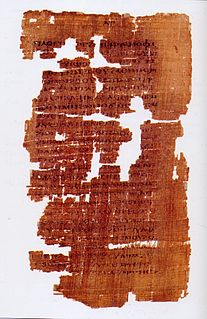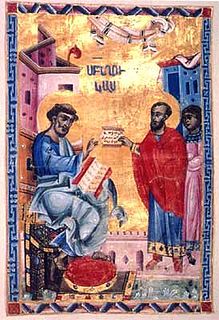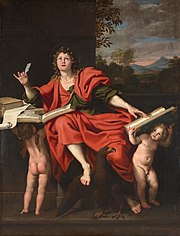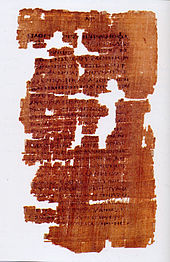
The Epistle of Paul to Titus, usually referred to simply as Titus, is one of the three pastoral epistles in the New Testament, historically attributed to Paul the Apostle. It is addressed to Saint Titus and describes the requirements and duties of elders and bishops.

The Gospel according to Luke, also called the Gospel of Luke or simply Luke, tells of the origins, birth, ministry, death, resurrection, and ascension of Jesus Christ. Together with the Acts of the Apostles, it makes up a two-volume work which scholars call Luke–Acts, accounting for 27.5% of the New Testament. The combined work divides the history of first-century Christianity into three stages, with the gospel making up the first two of these – the life of Jesus the Messiah from his birth to the beginning of his mission in the meeting with John the Baptist, followed by his ministry with events such as the Sermon on the Plain and its Beatitudes, and his Passion, death, and resurrection.

John the Evangelist is the name traditionally given to the author of the Gospel of John. Christians have traditionally identified him with John the Apostle, John of Patmos, or John the Presbyter, although this has been disputed by most modern scholars.

Luke the Evangelist is one of the Four Evangelists—the four traditionally ascribed authors of the canonical gospels. The Early Church Fathers ascribed to him authorship of both the Gospel of Luke and the Acts of the Apostles, which would mean Luke contributed over a quarter of the text of the New Testament, more than any other author. Prominent figures in early Christianity such as Jerome and Eusebius later reaffirmed his authorship, although a lack of conclusive evidence as to the identity of the author of the works has led to discussion in scholarly circles, both secular and religious.

Matthew the Apostle, also known as Saint Matthew and possibly as Levi, was, according to the New Testament, one of the twelve apostles of Jesus. According to Christian traditions, he was also one of the four Evangelists as author of the Gospel of Matthew, and thus is also known as Matthew the Evangelist, a claim rejected by the majority of modern biblical scholars, though the "traditional authorship still has its defenders."

The New Testament (NT) is the second division of the Christian biblical canon. It discusses the teachings and person of Jesus, as well as events in first-century Christianity. The New Testament's background, the first division of the Christian Bible, is called the Old Testament, which is based primarily upon the Hebrew Bible; together they are regarded as sacred scripture by Christians.

Timothy or Timothy of Ephesus was an early Christian evangelist and the first Christian bishop of Ephesus, who tradition relates died around the year AD 97.

John the Apostle or Saint John the Beloved was one of the Twelve Apostles of Jesus according to the New Testament. Generally listed as the youngest apostle, he was the son of Zebedee and Salome. His brother was James, who was another of the Twelve Apostles. The Church Fathers identify him as John the Evangelist, John of Patmos, John the Elder, and the Beloved Disciple, and testify that he outlived the remaining apostles and that he was the only one to die of natural causes. The traditions of most Christian denominations have held that John the Apostle is the author of several books of the New Testament.

Pseudepigrapha are falsely attributed works, texts whose claimed author is not the true author, or a work whose real author attributed it to a figure of the past.

The Acts of Paul and Thecla is an apocryphal story–Edgar J. Goodspeed called it a "religious romance"–of Paul the apostle's influence on a young virgin named Thecla. It is one of the writings of the New Testament apocrypha.

The Acts of John refers to a collection of stories about John the Apostle that began circulating in written form as early as the 2nd-century AD. Translations of the Acts of John in modern languages have been reconstructed by scholars from a number of manuscripts of later date. The Acts of John are generally classified as New Testament apocrypha.

John of Patmos is the name traditionally given to the author of the Book of Revelation. The text of Revelation states that John was on Patmos, a Greek island where, according to most biblical historians, he was exiled as a result of anti-Christian persecution under the Roman emperor Domitian.

The Acts of the Apostles is a genre of Early Christian literature, recounting the lives and works of the apostles of Jesus. The Acts are important for many reasons, one of them being the concept of apostolic succession. They also provide insight into the valuation of "missionary activities among the exotic races," since some of them feature missionary work done among, for instance, the Cynocephaly.

Christianity in the 1st century covers the formative history of Christianity from the start of the ministry of Jesus to the death of the last of the Twelve Apostles and is thus also known as the Apostolic Age.
The gospel of Luke and the Acts of the Apostles make up a two-volume work which scholars call Luke–Acts. The author is not named in either volume. According to a Church tradition, first attested by Irenaeus, he was the Luke named as a companion of Paul in three of the Pauline letters, but "a critical consensus emphasizes the countless contradictions between the account in Acts and the authentic Pauline letters." The eclipse of the traditional attribution to Luke the companion of Paul has meant that an early date for the gospel is now rarely put forward. Most scholars date the composition of the combined work to around 80–90 AD, although some others suggest 90–110, and there is textual evidence that Luke–Acts was still being substantially revised well into the 2nd century.
The historical reliability of the Gospels is the reliability and historic character of the four New Testament gospels as historical documents. While all four canonical gospels contain some sayings and events which may meet one or more of the five criteria for historical reliability used in biblical studies, the assessment and evaluation of these elements is a matter of ongoing debate. Almost all scholars of antiquity agree that a human Jesus existed, but scholars differ on the historicity of specific episodes described in the biblical accounts of Jesus, and the only two events subject to "almost universal assent" are that Jesus was baptized by John the Baptist and was crucified by the order of the Roman Prefect Pontius Pilate. Elements whose historical authenticity is disputed include the two accounts of the Nativity of Jesus, the miraculous events including the resurrection, and certain details about the crucifixion.

In Christian theology and ecclesiology, apostles, particularly the Twelve Apostles, were the primary disciples of Jesus according to the New Testament. During the life and ministry of Jesus in the 1st century AD, the apostles were his closest followers and became the primary teachers of the gospel message of Jesus. There is also an Eastern Christian tradition derived from the Gospel of Luke of there having been as many as seventy apostles during the time of Jesus' ministry.

Prochorus was one of the Seven Deacons chosen to care for the poor of the Christian community in Jerusalem. According to later tradition he was also one of the Seventy Disciples sent out by Jesus in Luke 10.
Acts 20 is the twentieth chapter of the Acts of the Apostles in the Christian New Testament of the Bible. It records the third missionary journey of Paul the Apostle. The book containing this chapter is anonymous, but early Christian tradition uniformly affirmed that Luke the Evangelist composed this book as well as the Gospel of Luke.















